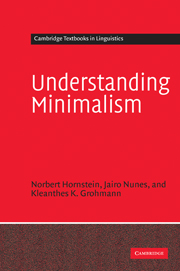Book contents
- Frontmatter
- Contents
- Preface
- List of abbreviations
- 1 The minimalist project
- 2 Some architectural issues in a minimalist setting
- 3 Theta domains
- 4 Case domains
- 5 Movement and minimality effects
- 6 Phrase structure
- 7 Linearization
- 8 Binding Theory
- 9 Feature interpretability and feature checking
- 10 Derivational economy
- Glossary of minimalist definitions
- References
- Language index
- Name index
- Subject index
6 - Phrase structure
Published online by Cambridge University Press: 05 June 2012
- Frontmatter
- Contents
- Preface
- List of abbreviations
- 1 The minimalist project
- 2 Some architectural issues in a minimalist setting
- 3 Theta domains
- 4 Case domains
- 5 Movement and minimality effects
- 6 Phrase structure
- 7 Linearization
- 8 Binding Theory
- 9 Feature interpretability and feature checking
- 10 Derivational economy
- Glossary of minimalist definitions
- References
- Language index
- Name index
- Subject index
Summary
Introduction
Recall from section 1.3 that one of the “big facts” regarding human languages is that sentences are composed of phrases, units larger than words organized in a specific hierarchical fashion. This chapter is devoted to phrase structure. The starting point for our discussion will be X′-Theory, the module of GB responsible for determining the precise format of licit phrases and syntactic constituents in general.
One of the main motivations for the introduction of X′-Theory into generative grammar was the elimination of a perceived redundancy in the earlier Aspects-model. The Aspects-theory of the base included two kinds of operations. First, there was a phrase-structure component based on a variety of context-free phrase-structure rules (PS rules) such as those in (1) below. (1a), for instance, states that a sentence S expands as (is formed by) NP Aux VP and (1b) says that a VP expands as a V with optional NP, PP, and S complements. The application of these sorts of rules generates phrase markers (trees) with no lexical items at the terminals, as illustrated in (2).
(1) Basic phrase-structure rules
S → NP Aux VP
VP → V (NP) (PP) (S)
NP → (Det) N (PP) (S)
Lexical elements were then introduced into the empty terminal positions (designated by e in (2)) by a process of lexical insertion, yielding phrase markers like (3).
- Type
- Chapter
- Information
- Understanding Minimalism , pp. 174 - 217Publisher: Cambridge University PressPrint publication year: 2005



